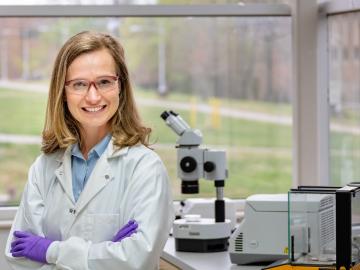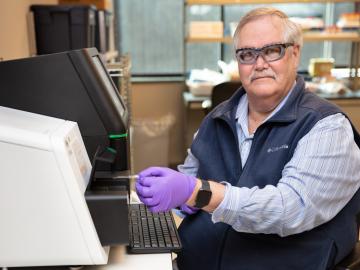
Filter News
Area of Research
- (-) Biology and Environment (56)
- (-) Isotopes (3)
- Advanced Manufacturing (8)
- Biological Systems (1)
- Biology and Soft Matter (1)
- Building Technologies (3)
- Clean Energy (109)
- Climate and Environmental Systems (2)
- Computational Biology (1)
- Computational Engineering (1)
- Computer Science (9)
- Electricity and Smart Grid (1)
- Functional Materials for Energy (2)
- Fusion and Fission (15)
- Fusion Energy (6)
- Materials (98)
- Materials for Computing (6)
- National Security (30)
- Neutron Science (37)
- Nuclear Science and Technology (11)
- Quantum information Science (3)
- Renewable Energy (1)
- Supercomputing (70)
- Transportation Systems (1)
News Topics
- 3-D Printing/Advanced Manufacturing (3)
- Advanced Reactors (1)
- Artificial Intelligence (3)
- Big Data (1)
- Bioenergy (16)
- Biology (26)
- Biomedical (3)
- Biotechnology (3)
- Buildings (1)
- Chemical Sciences (6)
- Clean Water (2)
- Climate Change (16)
- Composites (2)
- Computer Science (4)
- Coronavirus (2)
- Critical Materials (1)
- Cybersecurity (1)
- Decarbonization (8)
- Energy Storage (5)
- Environment (25)
- Exascale Computing (1)
- Frontier (1)
- Grid (2)
- High-Performance Computing (4)
- Hydropower (5)
- Isotopes (1)
- Machine Learning (3)
- Materials (5)
- Materials Science (3)
- Mercury (1)
- Microscopy (6)
- Nanotechnology (2)
- National Security (1)
- Net Zero (1)
- Neutron Science (1)
- Nuclear Energy (1)
- Partnerships (3)
- Polymers (1)
- Security (2)
- Simulation (1)
- Space Exploration (1)
- Summit (2)
- Sustainable Energy (10)
- Transformational Challenge Reactor (1)
- Transportation (1)
Media Contacts

Scientists have developed a novel approach to computationally infer previously undetected behaviors within complex biological environments by analyzing live, time-lapsed images that show the positioning of embryonic cells in C. elegans, or roundworms. Their published methods could be used to reveal hidden biological activity.

More than 50 current employees and recent retirees from ORNL received Department of Energy Secretary’s Honor Awards from Secretary Jennifer Granholm in January as part of project teams spanning the national laboratory system. The annual awards recognized 21 teams and three individuals for service and contributions to DOE’s mission and to the benefit of the nation.

Three ORNL scientists have been elected fellows of the American Association for the Advancement of Science, or AAAS, the world’s largest general scientific society and publisher of the Science family of journals.

Energy and sustainability experts from ORNL, industry, universities and the federal government recently identified key focus areas to meet the challenge of successfully decarbonizing the agriculture sector

A team of scientists led by the Department of Energy’s Oak Ridge National Laboratory and the Georgia Institute of Technology is using supercomputing and revolutionary deep learning tools to predict the structures and roles of thousands of proteins with unknown functions.

As a computational hydrologist at Oak Ridge National Laboratory, Ethan Coon combines his talent for math with his love of coding to solve big science questions about water quality, water availability for energy production, climate change, and the
A team of scientists led by Oak Ridge National Laboratory have discovered the specific gene that controls an important symbiotic relationship between plants and soil fungi, and successfully facilitated the symbiosis in a plant that

Amber McBride is using her expertise in nanotechnology, drug delivery, and disease models to research fundamental challenges in human health in the ORNL Biosciences Division.



